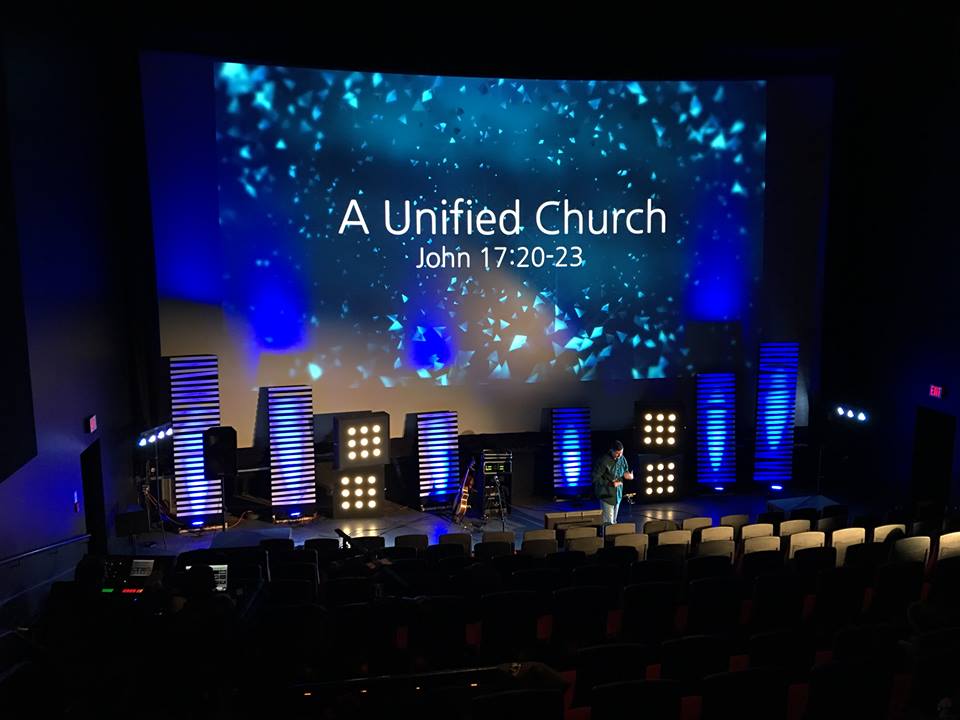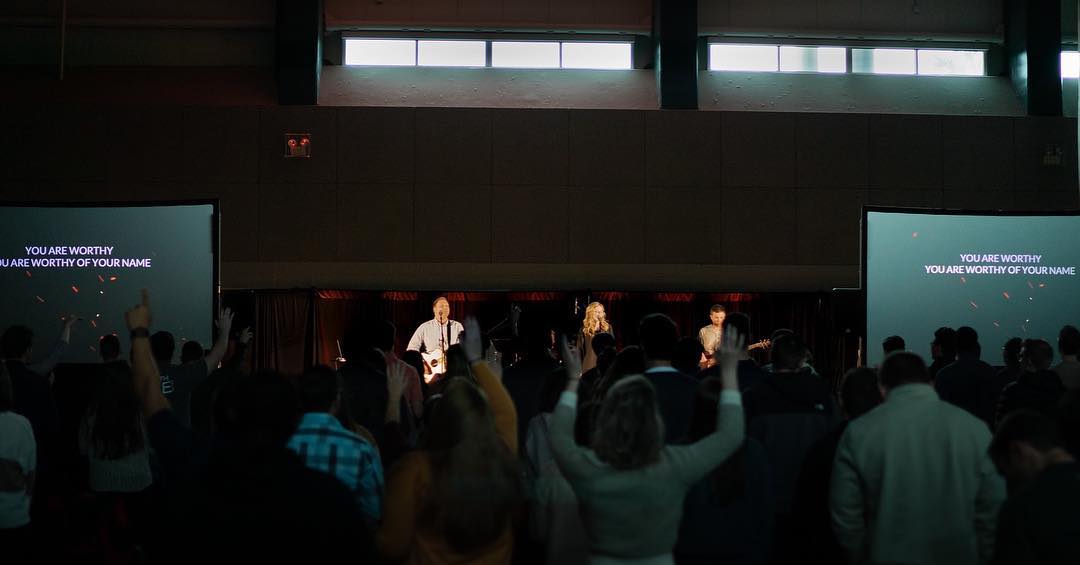By Brandon Elrod
(CALGARY) — Chris and Mindy Flora responded to God’s stirring in their hearts and moved to Canada in January of 2017 to reach a city whose population desperately needed the gospel.
“When we heard that the city of Calgary was 95 percent lost and one of the fastest growing cities in North America,” Chris said, “God broke our hearts for the city.”

Church planting missionary Chris Flora prays over the Multiply Church’s meeting place ahead of a Sunday morning service. Multiply launched in February 2018 in Calgary, one of the fastest growing cities in North America. Roughly 95 percent of the population does not know Jesus, and Multiply has seen eleven accept Christ and baptized seven new believers. Photo submitted by Chris Flora.
After inviting people to Bible studies, hosting block parties and summer camps and carefully cultivating relationships, the Floras launched Multiply Church in February 2018 with a core group of 28 people.
“It’s now about 130 people who call us home,” Chris said, “and we average between 60 and 70 people every week. We saw eleven accept Christ and seven baptized in our first year.”
Throughout the US and Canada, similar stories can be told of how God is blessing new congregations that are already making a significant gospel impact on individual lives and communities.
In Atlanta, an under-reached area in the gospel-soaked South, Mike McKee and his team launched Image Church in January 2018. They average 191 in worship attendance, have baptized 21 people and have built strong relationships within the community, especially a local elementary school they serve.

In Atlanta, an under-reached area in the gospel-soaked South, Mike McKee and his team launched Image Church in January 2018. They average 191 in worship attendance, have baptized 21 people and have built strong relationships within the community, especially a local elementary school they serve. Photo by Image Church.
Grace Church, in Boston, has a plan to multiply across the city, and in September 2018 they launched a third campus, Grace Church West Bridgewater, led by pastor Stephen Sargent. The new congregation has baptized 27 since its launch and on Easter Sunday 2019 they welcomed 667 people.
Last year, 878 churches were added to the ranks of Southern Baptists. Of those, 624 were new church plants and 254 became newly-affiliated, cooperating churches in the Southern Baptist Convention. Of those new church plants, 62 percent were either non-Anglo or multi-ethnic.
The North American Mission Board (NAMB), comes alongside churches, associations and state Baptist convention partners to plant new churches in North America.
“We plant churches everywhere for everyone,” said NAMB president Kevin Ezell. “We are incredibly grateful for each of these new churches and the missionaries who lead them, but we need so many more. We could plant a hundred more tomorrow if we had the qualified church planting missionaries to do it.”
NAMB has developed its strategy to help churches plant healthy churches that can thrive in cities and neighborhoods where their gospel witness is desperately needed.
“Over the years, we have continued to hone our church planting pathway so that our missionaries are able to start with a strong foundation,” said Dhati Lewis, vice president of the Send Network, NAMB’s church planting arm. “That enables these churches to be a lasting presence in communities for years to come.”
A key aspect to discovering and developing more of those missionaries has been the creation of the Send Network’s Multiplication Pipeline. The Send Network instituted multiplication as a core value within partner churches in order to encourage and equip church plants and establish churches to train new missionaries.
“We have been working to identify churches that we call ‘multiplying churches.’ These are congregations that intentionally disciple and lead their people by preparing them to become workers in the harvest,” Ezell said. “Any church, no matter the size, can multiply if they decide to do so. At NAMB, our goal is to help churches create this sending culture.”
To learn more and to involve your church in NAMB’s Multiplication Pipeline, visit namb.net/pipeline.
Brandon Elrod writes for the North American Mission Board.
MASHALLTOWN, Iowa (BP) — Southern Baptist Disaster Relief teams have begun cleanup work in Marshalltown, Iowa, following a devastating tornado July 19.
A Missouri Baptist Disaster Relief team arrived Tuesday to set up incident command at Iglesia Karios in Marshalltown. Chainsaw teams from Iowa have dispersed throughout the city to clear debris. An SBDR feeding team has prepared meals for recovery workers in the area.
Additional SBDR volunteers from Kansas-Nebraska and Florida already are on the ground in Marshalltown. Carlson, co-director of Iowa Baptist Disaster Relief, expects volunteers from other nearby states to arrive later this week and early next week. Teams from other states interested in providing assistance should contact their state disaster relief director.
“It looks like a war zone to tell you the truth,” Carlson said. “When you go downtown, you’ll see a lot of glass and brick everywhere.
“On the east part of town, there are about 10 blocks that are very heavily hit. There’s really not many trees standing. A lot of those homes aren’t livable,” Carlson said.
The EF-3 tornado injured at least 235 people in the town of 27,000 located 50 miles northeast of Des Moines. Carlson estimates that at least 100 homes were destroyed. Many more homes will take substantial work before people can return to live in them. Carlson believes it will take months, if not years, for Marshalltown to rebuild.
Some of the worst damage in Marshalltown came to the town’s courthouse and the brick buildings in the town square. In recent years officials and property owners had slowly worked to revamp the buildings, many of which are now destroyed. Jenny Etter, executive director of the Marshalltown Central Business District, estimates that the city had spent $50 million in building renovations since 2002.
A dozen or more tornadoes hit central Iowa last Thursday, according to the National Weather Service. The two biggest tornadoes, both rated EF-3, hit Marshalltown and Pella, with peak winds of 144 mph.
SBDR chaplains are also in Marshalltown to provide support and counsel to residents impacted by the tornado. Sam Porter, the North American Mission Board’s executive director of Southern Baptist Disaster Relief, prays the SBDR response will provide volunteers opportunities to share the Gospel.
“[The] number one goal with disaster relief is to earn the right to share the Gospel,” Porter said. “We work with those impacted. We treat them with respect. We pray with them. When they ask the question, ‘What makes you do this for no charge?’ that’s when you’ve earned the right to share the Gospel.”
The Marshalltown tornado comes on the heels of the SBDR response to flooding in Des Moines, Iowa, where teams wrapped up work last week. Eight people came to faith last week during SBDR efforts in the capital city, Carlson said.
Porter and Carlson urge Southern Baptists to pray for Marshalltown and the rest of Central Iowa.
“Pray for all the people who live here,” Carlson said. “A lot of them lost their homes. They lost their cars. They lost their job. There is a lot of a need here.”
Tobin Perry is a writer for the North American Mission Board.,
Published May 15, 2019